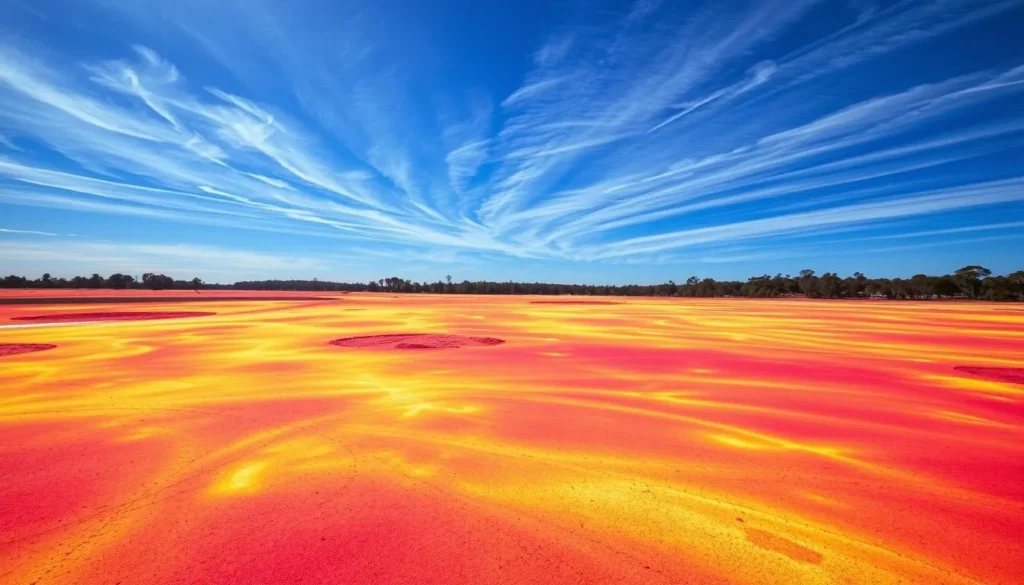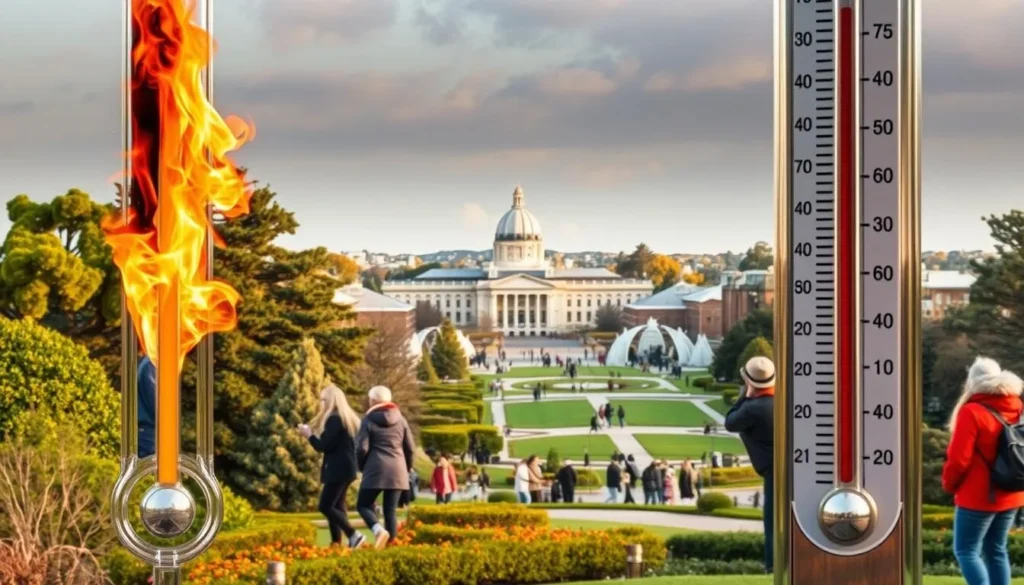✓ Accommodations✓ Flights✓ Rental Cars✓ Tours & Activities
Did you know that Canberra experiences four distinct seasons, offering a unique adventure throughout the year? With temperatures varying dramatically from 34°F to 82°F, choosing the right time to visit is crucial for making the most of your trip.
The best time for warm-weather activities in Canberra is from late December to early March, making it an ideal destination for those who enjoy mild summers. However, understanding the city’s climate patterns is key to a weather-savvy trip.
As you plan your visit, consider temperature patterns and seasonal events that can enhance your experience. Whether you’re looking for outdoor explorations or cultural experiences, this guide will help you make informed decisions about your Canberra trip.
Understanding Canberra’s Climate
Canberra’s climate is shaped by its unique geography. The city’s inland location at an elevation of approximately 1,900 feet above sea level significantly influences its weather patterns.
Geographic Influences on Weather Patterns
Canberra’s continental climate characteristics give it four clearly defined seasons with greater temperature variations than you might expect in Australia. The surrounding mountain ranges affect precipitation patterns and temperature fluctuations throughout the year, creating a climate distinct from Australia’s coastal cities.

Year-Round Climate Overview
Canberra experiences a significant variation in temperature between seasons and between day and night. The city receives about 25 inches of rain annually, distributed fairly evenly throughout the year. Here’s an overview of the average temperatures and rainfall patterns:
| Season | Average Temperature (°F) | Average Rainfall (inches) |
|---|---|---|
| Summer | 77 | 2.5 |
| Autumn | 64 | 2.2 |
| Winter | 45 | 2.0 |
| Spring | 64 | 2.3 |
Seasonal Weather Breakdown in Canberra
To make the most of your visit to Canberra, it’s vital to understand the city’s seasonal weather breakdown. Canberra experiences a diverse range of weather conditions throughout the year.
Summer (December to February)
Summer in Canberra is characterized by hot and dry weather, with temperatures often reaching the mid-80s°F. This period is ideal for outdoor activities and festivals.
Autumn (March to May)
Autumn brings mild temperatures, ranging between 41°F and 70°F, along with beautiful foliage, making it a comfortable season for sightseeing.
Winter (June to August)
Winter is cold, with daytime temperatures averaging 52°F and nights dropping to 34°F. Occasional frost and rare snowfall are also experienced during this time.
Spring (September to November)
Spring is marked by warming temperatures, from 40°F to 70°F, with increasing rainfall and blooming flowers. This season is highlighted by the famous Floriade festival.
| Season | Temperature Range | Characteristics |
|---|---|---|
| Summer | Mid-80s°F | Hot and dry, perfect for outdoor activities |
| Autumn | 41°F – 70°F | Mild temperatures, beautiful foliage |
| Winter | 34°F – 52°F | Cold, occasional frost, rare snowfall |
| Spring | 40°F – 70°F | Warming temperatures, increasing rainfall, blooming flowers |

Understanding the rainfall patterns across these seasons will help you prepare for your visit, regardless of when you choose to travel to the Australian Capital Territory.
Canberra, Australian Capitol Territory: Best Months for a Weather-Savvy Trip
For a weather-savvy trip to Canberra, understanding the best months to visit is key. The city’s climate varies significantly throughout the year, offering different experiences for visitors depending on when they choose to go.
Late December to Early March: Peak Tourism Season
Visiting Canberra from late December to early March means enjoying warm temperatures perfect for outdoor activities. This period represents the city’s peak tourism season, with major summer festivals attracting visitors from around the world. The last week of January is particularly popular, boasting the highest tourism score for warm-weather experiences.
March to May: The Autumn Sweet Spot
The “autumn sweet spot” from March to May offers mild temperatures and fewer crowds, creating an ideal environment for sightseeing. The beautiful fall colors during this period enhance the overall trip experience, making it a great time to explore Canberra’s outdoor attractions.
September to November: Spring Bloom
For those who prefer milder weather and the beauty of blooming flowers, September to November is an excellent time to visit. This period is highlighted by the spectacular Floriade festival, featuring over a million flowers in bloom. It’s a unique experience that showcases Canberra’s spring beauty.

Each of these periods offers different advantages in terms of weather, crowds, and special events, allowing you to tailor your trip to your specific interests and preferred activities.
Temperature Patterns to Plan Around
Planning a trip to Canberra requires knowledge of its temperature patterns to ensure a comfortable journey. Canberra’s climate is characterized by significant temperature variations throughout the year.
Daytime Highs Throughout the Year
Canberra’s daytime temperatures vary greatly from season to season. In summer, particularly in January, daytime highs can reach up to 82°F. In contrast, winter days in July average around 52°F. Understanding these daytime highs will help you plan your outdoor activities.

Nighttime Lows and Temperature Fluctuations
Nighttime temperatures in Canberra can drop significantly, even during summer. Evening temperatures often decrease by 10-15°F compared to daytime highs. In winter, nighttime lows can be quite cold, reaching as low as 34°F in July. This fluctuation requires careful planning of your wardrobe and activities.
| Month | Average High | Average Low |
|---|---|---|
| January | 82°F | 57°F |
| July | 52°F | 34°F |
Rainfall and Humidity Considerations
Understanding the rainfall and humidity in Canberra can significantly enhance your travel experience. Canberra receives about 25 inches of rain annually, with precipitation distributed fairly evenly throughout the year.
Wettest and Driest Months
The wettest month is typically November, with an average rainfall of 2.4 inches, while April is generally the driest, with just 1.5 inches of precipitation. You’ll find that the chance of rainfall on any given day throughout the year helps you plan outdoor activities with the lowest risk of weather disruption.

Humidity Levels and Comfort
Canberra’s humidity patterns remain relatively comfortable year-round, with very few days reaching truly muggy conditions even in summer. This contributes to the city’s reputation for generally pleasant weather conditions, making it an attractive destination for travelers. The comfortable humidity levels mean you can enjoy outdoor activities without the discomfort of high humidity.
Sunshine Hours and Daylight Planning
To maximize your time in Canberra, it’s essential to grasp the city’s sunshine hours and how daylight hours change across different seasons. This knowledge will help you plan your day effectively, ensuring you make the most of the available daylight.
Cloud Cover Throughout the Year
Canberra’s cloud cover varies significantly throughout the year. February stands out as the clearest month, with 71% clear days, making it ideal for outdoor activities and photography. In contrast, June is the cloudiest month, with 46% overcast days, which can impact your plans for sightseeing and outdoor explorations.
Daylight Hours by Season
The daylight hours in Canberra change dramatically across the seasons. The longest day, December 22, boasts 14 hours and 33 minutes of daylight, while the shortest day, June 21, has only 9 hours and 47 minutes. This variation affects your daily itinerary, especially during winter months when daylight is limited.
| Season | Daylight Hours | Cloud Cover |
|---|---|---|
| Summer | Longest daylight | Moderate cloud cover |
| Winter | Shortest daylight | Most cloud cover |
| Spring | Increasing daylight | Decreasing cloud cover |
| Autumn | Decreasing daylight | Moderate cloud cover |

Seasonal Events and Activities in Canberra

As the seasons change, Canberra comes alive with a variety of festivals and events that cater to all interests. Whether you’re looking for outdoor adventures, cultural experiences, or simply a unique experience, Canberra has something for everyone.
Summer Festivals and Outdoor Activities
Summer in Canberra is all about vibrant festivals and outdoor fun. You can enjoy outdoor concerts, food and wine events, and water activities on Lake Burley Griffin, taking full advantage of the warm weather. Experience the city’s summer festival scene, which is a perfect blend of entertainment and leisure.
Autumn Cultural Events
Autumn brings a rich cultural calendar to Canberra, featuring harvest festivals, wine events in the surrounding regions, and arts programs. The comfortable temperatures and beautiful fall colors make it an ideal time to explore the city’s cultural offerings. Enjoy the autumn colors and harvest festivals that make this season so special.
Winter Attractions and Indoor Options
Winter in Canberra offers a different kind of charm, with world-class museums and galleries providing perfect indoor activities for cooler days. For those seeking winter sports, the nearby Snowy Mountains offer exciting opportunities. Explore Canberra’s indoor attractions or head to the Snowy Mountains for a winter sports adventure.
Spring Celebrations and Floriade Festival
Spring is highlighted by the spectacular Floriade festival, held over September and October. This event showcases over a million blooms and has become Canberra’s signature annual event. Visit Floriade to witness the beauty of spring in Canberra, with its vibrant floral displays and lively atmosphere.
Each season in Canberra offers unique activities and events that can influence your decision on when to visit, allowing you to align your trip with experiences that match your interests.
Weather-Smart Packing Tips for Canberra
Packing for Canberra requires a thoughtful approach to accommodate the city’s diverse climate conditions. With significant day-to-night temperature fluctuations, often ranging 10-15°F, it’s essential to be prepared for varying weather conditions.
Essential Clothing for Each Season
For summer, pack lightweight, breathable clothing and effective sun protection. Don’t forget a light jacket for cool evenings. In winter, bring warm layers, a heavy jacket, and accessories like gloves and scarves for cold mornings. For spring and autumn, adaptable layering strategies are key.
- Summer: Lightweight clothing, sun protection, and a light jacket
- Winter: Warm layers, heavy jacket, gloves, and scarves
- Spring and Autumn: Adaptable layering for variable weather
Layering Strategies for Temperature Fluctuations
To combat Canberra’s temperature fluctuations, use a layering strategy. This allows you to adjust your clothing to suit the temperature, ensuring you’re comfortable throughout the day and night. Consider packing clothing items that can be layered, such as lightweight tops and bottoms, sweaters, and jackets.

Conclusion
Having examined Canberra’s climate throughout the year, you’re now in a position to decide the best month for your visit. With comprehensive information about the city’s weather patterns, you can choose a time that suits your temperature preferences and planned activities. Whether you prefer the warm summer days from late December to early March, the colorful autumn months (March-May), or the blooming spring (September-November), Canberra offers a unique experience each season.
You’re now equipped with practical packing strategies and activity recommendations to ensure a comfortable and memorable trip. This guide empowers you to plan a weather-savvy journey to the Australian Capital Territory, making the most of your time in this fascinating city.
The above is subject to change.
Check back often to TRAVEL.COM for the latest travel tips and deals.






